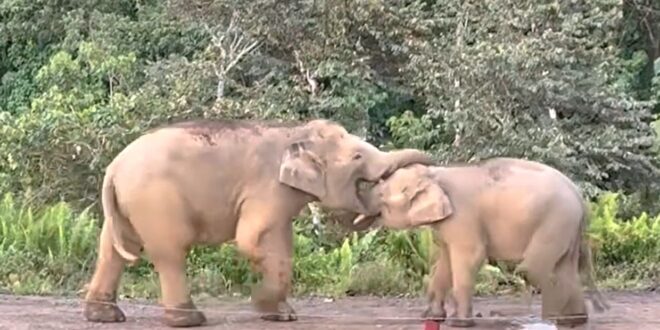KOTA KINABALU: A mother elephant’s gesture of using her trunk and body to gently steer her calf in the right direction caught Darmin Ladiro’s eyes recently.
Not wanting to tell the story without proof, he quickly took his camera out and recorded the moment.
“The mother elephant was trying to stop her baby from going to a nearby river. She was trying to lead the calf back into the forest. The constant gentle pushing continued for quite a while,” said the 50-year-old who described the moment as “cute”.
Darmin said sightings of Sabah’s iconic Borneon elephant, or locally known as the pygmy elephant, have been rare, until seven years back.
“Lately, they have been coming out a lot, maybe to look for food,” said the Bahasa Malaysia teacher at Sekolah Kebangsaan Umas-Umas in Tawau, located in the heart of an oil palm plantation,
Darmin explained that there is a tree planting project going on, where the non-productive trees are chopped, leaving the edible palm heart exposed.
“I guess the elephants are attracted to the palm heart, it is some sort of a food source for them. Hence, we get to see them more often now,” he said.
He said he first sighted elephants some 10 years back.
“Sometimes they come alone, or in pairs. But the most I’ve seen was seven years ago when a herd of 20 to 30 adults and calves were walking along the Kalabakan Road, which now separates the area that used to be their habitat.
“It was beautiful and scary at the same time. But no human or the mammals were hurt in the incident,” he said.
Since then, elephants have been spotted on main roads quite often, so much so that signboards were erected to alert motorists of the elephant crossing.
He said lately, elephant sightings have become common as they would be seen ‘visiting’ villages around Felda Umas, Benta Wawasan (Dumpas), Kalabakan and Luasong, which used to be their habitat.
Darmin admits that human-elephant conflict does exist but mainly because both are fighting for space, adding: “I have not heard of any elephant killing or abuse.”
Recently, the International Union for Conservation of Nature’s (IUCN) Red List of Threatened Species had listed the Borneo elephants, a distinct subspecies of Asian elephants, as endangered.
In total, there are just about 1,000 let, including 400 breeding adults, primarily found in Sabah with a small population in Indonesia’s Kalimantan, and IUCN calls for the urgency of conservation efforts to protect these genetically unique elephants.
 BeritaKini.biz Berita Viral Terkini di Malaysia
BeritaKini.biz Berita Viral Terkini di Malaysia





